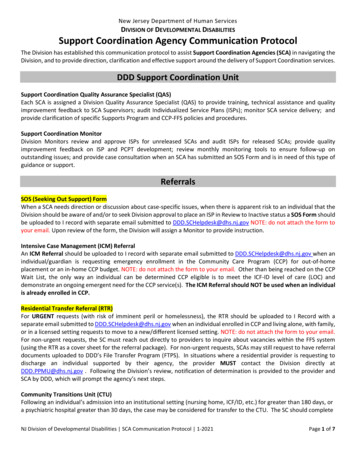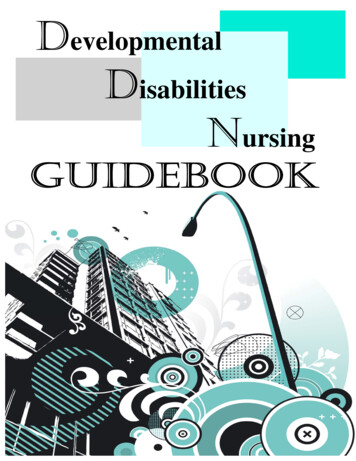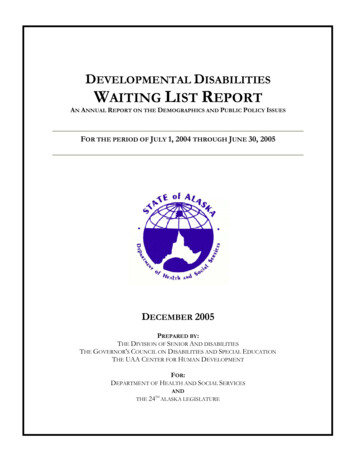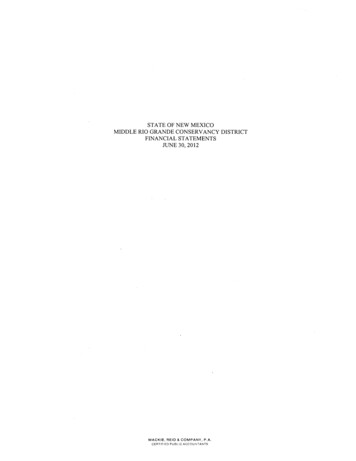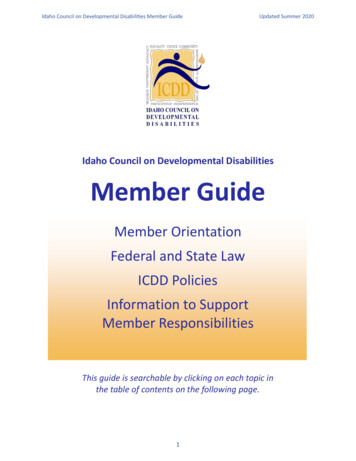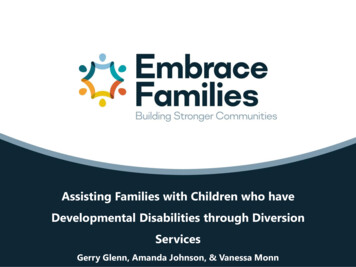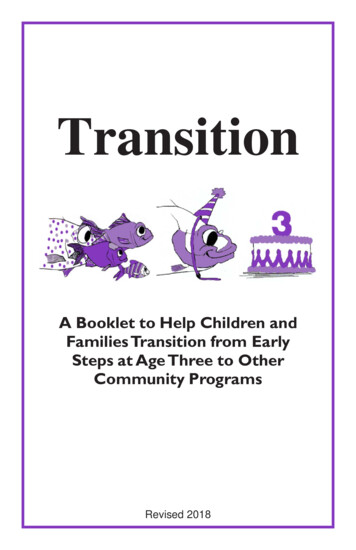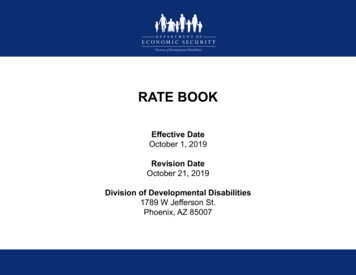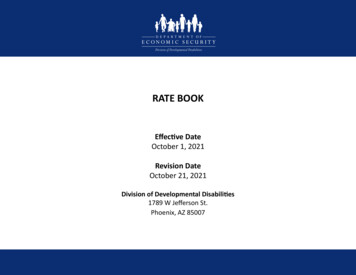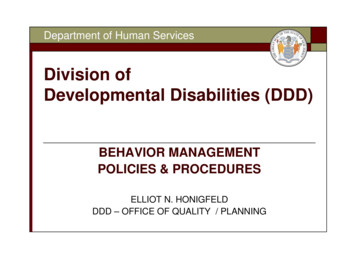
Transcription
Department of Human ServicesDivision ofDevelopmental Disabilities (DDD)BEHAVIOR MANAGEMENTPOLICIES & PROCEDURESELLIOT N. HONIGFELDDDD – OFFICE OF QUALITY / PLANNING
Department of Human ServicesIn order to effectively address significantbehavioral needs of service recipientsincluding those of individuals that havebeen assessed atDDRT Levels 3 – 4 (Behavioral)a service provider must have
Department of Human Services DDD ApprovedBehavior Support Policy and Procedure – thatcomports to the requirements of DivisionCircular #34andPolicy and procedure covering the utilization ofDefensive Techniques and Personal ControlTechniques (PCT) (Division Circular #19)
Department of Human ServicesBehavior Support Policy and Procedure– Describes the process forDevelopment, Implementation and Oversightof Behavior Support Plans.Behavior Support Plans are clinical interventionsdesigned to modify identified behaviorsutilizing the principles ofApplied Behavioral Analysisincluding Positive Behavioral Supports
Department of Human ServicesPersonal Control TechniquesPersonal Control Techniques (PCT) inEmergencies are emergency measures takenresponse to aggressive, destructive and/orself-injurious behaviors, when such behaviorspresent a danger to the individual or others.
Department of Human ServicesBehavior ManagementTaken together Behavior Support Policy and ProcedureandPersonal Control Techniquesprovide a basic set of tools by which behaviorcan be shaped proactively over time as well asthe safe, effective means to physicallyintervene and maintain safety duringdangerous behavioral episodes.
Department of Human ServicesNotes All DDD Circulars available on our ws/publications/divisioncirculars.htmlOnly these two policies are reviewed andapproved by DDD (Behavior Policy ReviewCommittee) other operational P&P for residential / out of home servicesare reviewed by DHS’s Office of Licensing (DDL).
Department of Human ServicesNoteThe Qualified Provider process and determinationis separate from this requirement to haveapproved Behavior Management P & P.No Qualified Provider may provide services orrespond to E Blasts to serve this populationwithout first having these policies andprocedures approved by the Division
Department of Human ServicesDivision Circular #34BEHAVIOR SUPPORTPOLICY AND PROCEDURE
Department of Human ServicesBEHAVIOR SUPPORT POLICY AND PROCEDUREIn order to meet the requirements of the currentand upcoming revision to DC#34use the Appendix A format to submit keyprovisions of the Agency / Providerbehavioral supports policy & procedure toDDD for review and approval.
Department of Human ServicesAppendix AThe Appendix A submission is designed to providethe Division with a focused overview andsummary description of the service provider’sbehavioral support policies and procedures byconcisely outlining the processes, responsibleparties and timeframes involved with identifyingbehavioral service needs and providing behavioralsupports including the development andimplementation of a Behavior Support Plan (BSP).
Department of Human ServicesNoteSubmission of the Appendix A replaces the priorpractice of submitting either a Behavior Manualor a behavior management Memorandum ofUnderstanding (utilizing the CommunityServices Behavior Management Manual) toDDD for review and approval
Department of Human ServicesSome key elements from P&P to be reflected in theAppendix ADescription of the processes, timeframes and stafftitles responsible for: Identifying target behavior including the Assessment of Behavioral Risk Conducting Behavioral Assessment / FunctionalAnalysis Plan development Garnering approvals / consent Plan monitoring and documentation.
Department of Human ServicesNoteAssessment of Behavioral RiskOn an annual and ongoing basis, the IDT willassess if there are any Behavioral Risksassociated with the behavior of the individual.If identified, a Behavior Support Plan will bedeveloped to address this behavior
Department of Human ServicesNote - continuedBehavioral Risk defined:“When determined by the IDT, the behavior ofthe individual poses a credible, potentialrisk to the health or safety of the individual,staff or others in the person's community.”
Department of Human ServicesSome key elements from P&P to be reflected in theAppendix A - continued Indicate which Human Rights Committee (HRC) andBehavior Support Committee (BSC) would beutilized. Identify any external parties, partners or consultantsthat will be responsible to routinely perform any keybehavior support functions as a part of your process.Delineate responsibilities by organization and title.
Department of Human ServicesSome key elements from P&P to be reflected in theAppendix A - continuedDescribe your staff training process and curricula relativeto: Providing an overview of behavioral supportsProviding specific training on individual behaviorsupport plansAssuring mastery and retention of skills.
Department of Human ServicesSome key elements from P&P to be reflected in theAppendix A - continuedSUPERVISION AND ADMINISTRATIVEOVERSIGHTIdentify staff titles responsible for the direct supervisionof behavior support plans, including: Observing plan implementation Monitoring data collection / accuracy.
Department of Human ServicesSome key elements from P&P to be reflected in theAppendix A - continuedSUPERVISION AND ADMINISTRATIVEOVERSIGHTDescribe the quality oversight system, based upon theadministrative auditing of 20% of individual behaviorsupport plans, to compile data on overall behavioralservice delivery within the organization.Metrics – Training requirements have been met. Data collection is timely and accurate. There is a documented review of outcomes Required initial & ongoing reviews and approvals aredocumented
Department of Human ServicesCredentials for Behavioral Support Plandevelopment / oversight If the Behavior Support Plan (BSP) addressesA Behavioral Risk associated with the behavior,orif a BSP uses a technique which requires greaterproficiency / oversight*The BSP will be reviewed, approved and operateunder the supervision of an individual with at least aMaster’s degree in a specified field, along with at leastone year of experience in the development andimplementation of BSPs for individuals who havedevelopmental disabilities.
Department of Human ServicesNote* BSP’s requiring greater proficiency / oversight The employed Behavior Support Technique istechnically complex, has the potential to cause aviolation of Human Rights or otherwise requires ahigher level of review, approval and oversightincluding the following
Department of Human ServicesExamples –techniques requiring greater proficiency / oversight Token or point systems utilizing response costSubstantive alteration to the usual environment orroutine - for the specific purpose of behavioralcontrol – (restricted access, monitoring devicesetc.)Physical prompting and/or manual guidance toovercome significant resistance
Department of Human ServicesExamples - continued Contingent presentation of non-preferred sensoryor physical stimuliPhysical restraint of the body, by any means, aspart of a BSPOvercorrection or contingently required physicalactivityAny exclusionary time out procedure over five (5)minutes in durationALL CURRENT DC#34 “Level III”TECHNIQUES
Department of Human ServicesDivision Circular #19Defensive Techniques andPersonal Control TechniquesPOLICY AND PROCEDURE
Department of Human ServicesDivision Circular #19 - continued even in a supportive environment, someindividuals will exhibit aggressive,destructive and/or self-injurious behaviors.When such behaviors present a danger to theindividual or others action must be taken tohelp the individual control himself or herself,or, if that is not possible, to control theindividual.
Department of Human ServicesDivision Circular #19 - continued .When the individual exhibits unanticipateddangerous behavior, emergency measuresmust be available to assist in protecting theindividual or others. Among the emergencymeasures that are used in such situations arepersonal control techniques.
Department of Human ServicesWhat areDefensive Techniques? Techniques to block and deflect punches andkicks Methods to release grabs, bites and hairholds
Department of Human ServicesWhat ArePersonal Control Techniques (PCT)? PCT is a form of RESTRAINT PCT mean contact by staff with an individual,which restricts the individual’s freedom ofmovement either partially or totally. Common types of PCT include:Bear Hugs, Basket Holds and Take Downs
Department of Human ServicesNote Personal Control Techniques shall not be usedas punishment, for the convenience of staff, oras a substitute for programming. Only Staff that has successfully completed atraining program approved by the Divisionshall apply Personal Control and DefensiveTechniques.
Department of Human ServicesPrompting vs. Restraint (PCT) Prompts, using manual guidance, aredistinct from restraint. Examples include:Lead-alongs, escorting and hand overhand assistance for training
Department of Human ServicesHealth / Medical Review Prior to PCT UseIn Community Programs licensed for persons withdevelopmental disabilities, the IDT reviews theavailable client record for documented sign ofphysical distress. If the IDT has any questionconcerning the use of a personal controltechnique, the use of the personal controltechnique in question should not be authorizeduntil a physician reviews the technique and theindividual record, evaluates the individual, asnecessary, and approves its use. If the IDT notesno concerns, the personal control technique maybe used.
Department of Human ServicesWhat about Devices used to controlbehavior?Such as Helmets Mitts / gloves Harnesses / Jumpsuits Arm splints / shin splints Bed Rails
Department of Human ServicesMechanical RestraintThese devices, used to control behavior, areconsidered forms of Mechanical Restraint andare addressed in Division Circular #20.“Mechanical restraint” means the application ofa devise which restricts freedom of movementeither partially or totally.
Department of Human ServicesMechanical Restraint vs. Safeguarding“Safeguarding equipment” means devices which restrictmovement used to provide support for theachievement of functional body position or properbalance; devices used for specific medical, dental orsurgical treatment; and devices to protect theindividual from symptoms of existing medicalconditions, including, but not limited to, seizures,ataxia and involuntary self abuse.
Department of Human ServicesMechanical Restraint vs. Safeguarding -continuedDevices such as bed rails, mitts, jumpsuits, arm splints,vest, helmets and body harnesses (are either used) asa mechanical restraint for control purposes orsafeguarding equipment, depending uponcircumstances. For example, a helmet used toprevent injury due to seizures is a safeguardingdevice. Use of a helmet to prevent injury due to selfinjurious behavior is for control purposes(Mechanical Restraint).
Department of Human ServicesApplication To Use Mechanical Restraints Each facility or service provider requesting approval to utilizemechanical restraint shall submit to the Division Director(BPRC) a comprehensive written procedure governing the useof restraint which shall include: Identifyingthe forms of mechanical restraint to be usedand the number of trained staff that shall be available toapply restraints; Criteriafor use of mechanical restraints Instructionsfor the application of the restraint
Department of Human ServicesApplication To Use Mechanical Restraints Continued Precautionsfor the use of mechanical restraintinvolving certification by a physician that the useof the restraint is not medically contraindicativefor the individual Record Akeeping and review requirementscurriculum for training staff in the proper useand application as well as the recognition of thesigns of physical distress.
POLICIES & PROCEDURES ELLIOT N. HONIGFELD DDD - OFFICE OF QUALITY / PLANNING. Department of Human Services . dental or surgical treatment; and devices to protect the individual from symptoms of existing medical conditions, including, but not limited to, seizures, . For example, a helmet used to prevent injury due to seizures is a safeguarding
